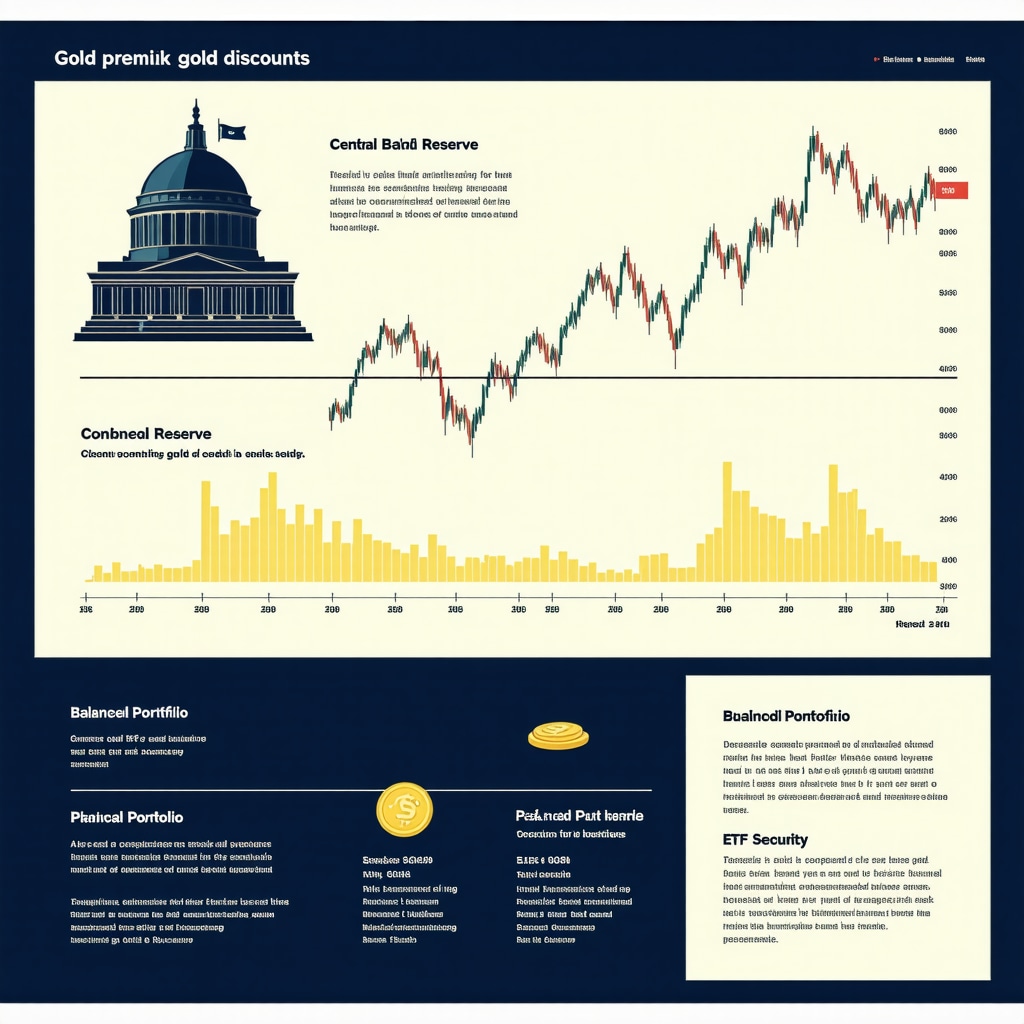Gold’s Glittering Allure: More Than Just Bling in Your Portfolio
Imagine sitting at a café, sipping coffee, while overhearing a heated debate about the best form of gold investment. Bars? Coins? ETFs? Each has its staunch defenders, and it’s easy to see why. Gold isn’t just a shiny metal; it’s a timeless hedge, a tangible asset, and a portfolio staple that sparks both passion and puzzlement among investors. So, what’s the real scoop on choosing between these golden options?
Bars, Coins, or ETFs: The Triathlon of Gold Investments
Let’s dive right in with a glance at each contender’s unique charm and quirks. Physical gold bars offer a hefty punch of purity and heft, often favored by those who crave tangibility and control. They’re like the heavyweight champions of the gold world, but beware: storage and security aren’t trivial matters. If you’re curious about buying bars safely, the expert tips on secure physical gold investments are a must-read.
Gold coins, on the other hand, add a splash of artistry and collectability to your portfolio alongside value. They’re the charming storytellers of gold, often carrying historical significance and numismatic intrigue. Yet, their premiums over spot price can be higher, so it pays to do your homework. For beginners eager to navigate this sparkling niche, this guide to gold coin investing offers valuable insight.
Then there’s the sleek, digital allure of Gold ETFs—exchange-traded funds that allow you to dip into the gold market without the hassle of physical storage. They’re perfect for investors who want liquidity and ease, blending gold’s stability with stock-like flexibility. Curious about building a diversified portfolio with ETFs? Check out top gold ETFs and mutual funds to buy for long-term growth.
Is Physical Gold Always the ‘Golden Standard’?
It’s tempting to think that holding physical gold bars or coins is the ultimate investment. But is it always the best choice? Physical gold offers undeniable peace of mind—there’s something profoundly reassuring about knowing your wealth is literally in your hands. However, the costs of storage, insurance, and potential liquidity challenges can make it less nimble compared to ETFs.
Conversely, Gold ETFs, while convenient, expose investors to market risks and sometimes management fees that chip away at returns. The balance between tangibility and convenience is a delicate dance, and your personal goals and risk appetite should lead the choreography.
Why Does Gold’s Supply and Demand Dance Matter?
Understanding the subtle rhythms of gold supply and demand is crucial in this investment waltz. Factors like geopolitical tensions, central bank purchases, and economic shifts can sway prices dramatically. As Investopedia notes, gold often shines brightest when economic uncertainty looms, making timing and knowledge your best allies.
For a deeper dive, exploring gold supply and demand dynamics can arm you with insights to make smarter investment decisions.
So, fellow investors, what’s your golden take? Do you clutch cold, hard bars, admire the artistry of coins, or embrace the digital ease of ETFs? Share your thoughts and experiences below—because in the shimmering world of gold, every perspective adds value.
The Intricacies of Gold Storage: Security Beyond the Shine
When investing in physical gold bars or coins, one often underestimates the complexities involved in secure storage. The cost of safe deposit boxes, home safes, or professional vault services can significantly eat into your returns. Moreover, insurance premiums add another layer of expense, and the risk of theft or loss remains a tangible concern. These factors compel many investors to weigh the trade-offs carefully between security and convenience.
For those interested in mastering the logistics of physical gold ownership, best practices for buying and storing gold bullion safely provide essential guidelines that can safeguard your investment against unforeseen pitfalls.
Gold ETFs and Mutual Funds: Flexibility Meets Market Dynamics
Gold ETFs offer unparalleled liquidity and ease of trading, but they come with their own set of intricacies. Unlike physical gold, these financial instruments expose investors to market volatility and management fees that may erode gains over time. Additionally, ETFs do not provide the tactile assurance that physical gold does, which can be a psychological factor for many investors.
Mutual funds focused on gold mining stocks add another dimension, offering exposure to companies that can benefit from rising gold prices. However, these stocks carry company-specific risks and market fluctuations distinct from the price of gold itself. Exploring gold ETFs and mutual funds for diversified portfolios helps investors tailor their exposure to match individual risk tolerances and investment horizons.
How Do Geopolitical Uncertainties Shape Gold’s Market Trajectory?
Gold’s role as a safe haven is often amplified during times of geopolitical tension. Conflicts, trade disputes, and political instability can trigger increased demand, driving prices upward. However, the timing and magnitude of these price movements are influenced by a complex interplay of factors including central bank policies and global economic conditions.
According to the World Gold Council, geopolitical events historically serve as catalysts for spikes in gold demand, underscoring the metal’s function as a strategic asset in uncertain times. For a comprehensive understanding, their gold demand trends research offers authoritative insights into how these dynamics unfold.
Balancing Portfolio Stability with Gold Investment Strategies
Incorporating gold into your portfolio is not merely about choosing bars, coins, or ETFs but about crafting a strategy that aligns with your financial goals and risk profile. Diversification across different forms of gold investments can mitigate specific risks associated with each. For example, pairing physical gold with ETFs may offer a blend of security and liquidity.
Investors seeking to enhance wealth protection and growth might find value in exploring top gold investment strategies to protect wealth in 2025, which provide actionable insights tailored to current market conditions.
What’s your approach to integrating gold into your investment portfolio? Share your experiences or questions below to enrich this ongoing conversation about gold’s multifaceted role in financial planning.
Unlocking the Nuances of Gold Liquidity: Strategies for Sophisticated Investors
Liquidity in gold investment extends beyond the mere ability to buy or sell quickly; it involves understanding market depth, bid-ask spreads, and timing trades to optimize returns. Physical gold, while tangible, often suffers from liquidity constraints due to the need for authentication, secure transport, and potential premiums or discounts depending on market conditions and dealer availability. Conversely, Gold ETFs offer near-instant liquidity but are subject to market fluctuations and operational risks tied to fund management and counterparty exposures.
Advanced investors often employ a hybrid approach, leveraging physical gold’s stability as a long-term store of value while utilizing ETFs for tactical trading. This dynamic allows for rapid repositioning in response to macroeconomic indicators without sacrificing the foundational security of physical assets. Additionally, some experts recommend allocating a portion of portfolios to gold futures and options, instruments that, while complex, provide leverage and hedging opportunities but require in-depth knowledge and risk management strategies.
What Are the Implications of Central Bank Gold Reserves on Private Investment Decisions?
Central banks are significant players in the gold market, often adjusting their reserves based on monetary policy goals, currency stability, and geopolitical considerations. When central banks increase gold holdings, it often signals diminished confidence in fiat currencies or a strategic shift toward asset diversification, which can drive global gold prices upward.
For private investors, monitoring central bank gold reserve trends offers critical foresight. The World Gold Council’s Central Bank Reserves Data provides granular, up-to-date insights into these movements. Recognizing patterns such as accumulation phases or selling pressures can inform timing and scale of personal investments, aligning them with macroeconomic trajectories rather than isolated market sentiments.
Decoding Gold Premiums and Discounts: Mastering Price Anomalies for Optimal Entry
Gold premiums and discounts reflect the difference between the spot price and the actual transaction price of physical gold or ETFs. Factors influencing these include dealer inventory levels, geopolitical fears, demand surges, and logistical bottlenecks. For example, during times of crisis, premiums on physical gold can soar as investors scramble for immediate safe-haven assets, while ETF prices might lag due to market regulations or redemption processes.
Expert investors track these anomalies closely to identify lucrative entry points. Buying physical gold when premiums are low relative to spot price or acquiring ETFs during temporary price dips can significantly enhance returns. Utilizing real-time market analytics platforms and dealer reports is essential for such precision strategies.
Innovative Gold Investment Vehicles: Beyond Traditional Forms
The gold investment landscape has evolved to include novel financial instruments such as digital gold tokens, gold-backed cryptocurrencies, and fractional ownership platforms. These innovations promise enhanced accessibility and liquidity but also introduce regulatory uncertainties and counterparty risks. Experienced investors weigh these factors carefully, often integrating these assets as complements rather than replacements for traditional holdings.
Moreover, environmental, social, and governance (ESG) considerations are increasingly influencing gold sourcing and investment decisions. Ethical mining practices and transparent supply chains are becoming critical evaluation criteria, shaping premium valuations and investor preferences.
How Can Investors Leverage Gold’s Role in Inflation Hedging Amid Varying Economic Cycles?
Gold’s inflation-hedging capabilities depend heavily on the economic context and the nature of inflationary pressures. During demand-pull inflation, gold tends to perform well as real yields fall, whereas cost-push inflation or stagflation can produce mixed outcomes. Investors deploying gold as an inflation hedge must therefore consider macroeconomic indicators such as real interest rates, currency strength, and fiscal policy trajectories.
Integrating gold with complementary assets like inflation-protected securities or diversified commodities can enhance portfolio resilience. Strategic rebalancing in response to inflation expectations is a nuanced yet vital tactic that can optimize gold’s protective benefits.
For those eager to deepen their mastery, exploring CFA Institute’s research on gold as an inflation hedge offers rigorous analysis grounded in empirical data.
Embracing Complexity: Tailoring Gold Investment Portfolios for the Modern Investor
Building a sophisticated gold portfolio demands more than selecting a single product; it requires a strategic blend that aligns with risk tolerance, investment horizon, and market outlook. This might mean pairing physical gold’s security with ETFs’ agility, integrating mining stocks for growth potential, and cautiously exploring emerging digital gold assets.
The key lies in continuous market education, vigilant monitoring of geopolitical and economic shifts, and agile portfolio adjustments. Engaging with expert analyses and participating in investment communities can provide critical perspectives that refine decision-making.
Ready to elevate your gold investment strategy? Dive into our advanced resources and join the conversation to harness gold’s multifaceted potential as a cornerstone of resilient wealth preservation.
Decoding Gold Premiums and Discounts: Mastering Price Anomalies for Optimal Entry
Astute gold investors understand that the price gap between spot gold and actual transaction costs — commonly known as premiums and discounts — can make or break investment returns. These price discrepancies arise from multifaceted causes such as inventory scarcity among dealers, surges in geopolitical risk appetite, and logistical limitations affecting physical delivery. For example, during periods of heightened uncertainty, premiums on physical gold bars and coins can skyrocket, reflecting urgent demand and limited supply, while ETFs might trade closer to spot but carry management fees affecting net gains.
Seasoned traders leverage these anomalies by timing their purchases and sales to capitalize on favorable spreads. Monitoring real-time dealer quotes and market analytics enables identifying windows when physical gold is priced attractively relative to spot, or when ETF shares are temporarily undervalued. To deepen your understanding, exploring how to analyze gold market trends for smarter investment moves offers practical methodologies for navigating these complexities.
Central Bank Gold Reserves: Strategic Signals for Private Investors
The maneuvers of central banks in the gold arena reverberate strongly through private investment corridors. Central banks adjust gold reserves to diversify foreign currency risks, bolster monetary stability, or project geopolitical influence. Notably, increased reserve accumulation often precedes or coincides with upward gold price trends, reflecting waning confidence in fiat currencies or anticipation of economic turbulence.
Private investors who track these trends gain a strategic vantage point, aligning their portfolio decisions with macroeconomic signals rather than isolated price movements. The top central bank gold purchases impacting 2025 market trends provide detailed insights into how these institutional shifts may shape the gold market landscape this year.
How Can Sophisticated Investors Optimize Gold Liquidity Without Sacrificing Security?
Balancing liquidity and security in gold investment is a nuanced art. Physical gold offers unassailable tangibility but often entails liquidity constraints due to authentication protocols, transport logistics, and market premiums. Conversely, Gold ETFs deliver near-instant liquidity and ease of trade but carry counterparty risks and lack physical ownership assurance.
Advanced investors often adopt hybrid strategies combining physical gold as a stable, long-term store of value with ETFs for tactical agility in volatile markets. Further sophistication comes from integrating derivative instruments like gold futures and options, which afford leverage and hedging capabilities but demand rigorous risk management and market expertise.
To refine your liquidity tactics, consider consulting effective gold trading strategies for volatile markets, which detail approaches tailored for dynamic market environments.
Engage with us: How do you strike the balance between liquidity and security in your gold investments? Share your experiences or questions below to enrich this expert-level dialogue and help shape smarter investment approaches in 2025 and beyond.

Expert Insights & Advanced Considerations
Gold’s Role as a Dynamic Portfolio Stabilizer Goes Beyond Traditional Assumptions
While many investors perceive gold primarily as a hedge against inflation and geopolitical uncertainty, its nuanced behavior in diversified portfolios reveals deeper strategic value. For example, integrating gold ETFs with select mining stocks can balance liquidity with growth potential, while physical gold anchors long-term wealth preservation. This multifaceted approach demands active portfolio management informed by ongoing market intelligence.
Mastering Gold Premiums and Discounts Is Key to Optimized Entry Points
Astute investors monitor real-time premiums and discounts between spot prices and transaction costs, leveraging market inefficiencies. Recognizing when physical gold premiums spike due to supply constraints or when ETFs offer temporary price anomalies can yield significantly enhanced returns. This level of sophistication requires access to detailed market data and a disciplined trading mindset.
Central Bank Gold Movements Offer Critical Strategic Signals
Central banks’ gold reserve adjustments are powerful indicators often preceding broader market trends. Understanding these institutional shifts provides private investors with a macroeconomic compass, enabling more informed timing and sizing of investments. Tracking these patterns through reliable sources can elevate investment strategies beyond reactive decisions.
Hybrid Liquidity Strategies Empower Tactical Agility Without Sacrificing Security
Balancing the tangible security of physical gold with the near-instant liquidity of ETFs and derivatives allows sophisticated investors to respond swiftly to market volatility. Incorporating instruments like gold futures and options introduces leverage and hedging opportunities but requires rigorous risk controls and expertise.
Emerging Digital Gold Assets and ESG Considerations Are Reshaping Investment Paradigms
Digital gold tokens and gold-backed cryptocurrencies provide new avenues for fractional ownership and accessibility, though they come with regulatory and counterparty risks. Simultaneously, ESG factors increasingly influence gold sourcing and investor preferences, prompting a shift toward ethically mined gold and transparent supply chains that may command premium valuations.
Curated Expert Resources
- World Gold Council – Gold Demand Trends Research: Offers comprehensive data and analysis on global gold demand fluctuations influenced by geopolitical and economic factors, essential for informed investment timing. (https://www.gold.org/goldhub/research/gold-demand-trends)
- BuyingGoldNow’s Guide on Gold Supply and Demand Dynamics: Deep dive into the forces shaping gold prices and strategic investment responses. (https://buyingoldnow.com/gold-supply-and-demand-dynamics-insights-for-smart-investors)
- CFA Institute Research on Gold as an Inflation Hedge: Empirical analysis that elucidates gold’s nuanced performance across different inflationary environments. (https://www.cfainstitute.org/en/research/cfa-digest/2020/12/gold-as-an-inflation-hedge)
- BuyingGoldNow’s Effective Gold Trading Strategies for Volatile Markets: Tactical approaches to navigate gold price volatility using a blend of physical and financial instruments. (https://buyinggoldnow.com/effective-gold-trading-strategies-for-volatile-markets)
- BuyingGoldNow’s Top Gold Investment Strategies to Protect Wealth in 2025: Actionable insights tailored for the current market cycle to maximize portfolio resilience. (https://buyinggoldnow.com/top-gold-investment-strategies-to-protect-wealth-in-2025)
Final Expert Perspective
In the intricate realm of gold investing, a one-size-fits-all approach falls short. The most impactful strategies emerge from a sophisticated understanding of gold’s multifaceted roles—ranging from a tangible store of value to a flexible financial instrument—and the external forces shaping its market dynamics. By mastering premiums and discounts, monitoring central bank activities, and embracing hybrid liquidity tactics, investors can position themselves not just to protect wealth, but to capitalize on nuanced opportunities. The evolving landscape, including digital gold assets and ESG considerations, further invites a proactive, informed stance.
For those ready to deepen their expertise and refine their gold investment approach, exploring advanced resources like gold supply and demand dynamics and top gold investment strategies will provide invaluable guidance. Engage with these insights, contribute your perspectives, and elevate your portfolio’s resilience in the ever-shifting gold market landscape of 2025 and beyond.
What advanced gold investment strategies have you found most effective? Share your experiences and join the conversation to foster a community of informed and empowered investors.










